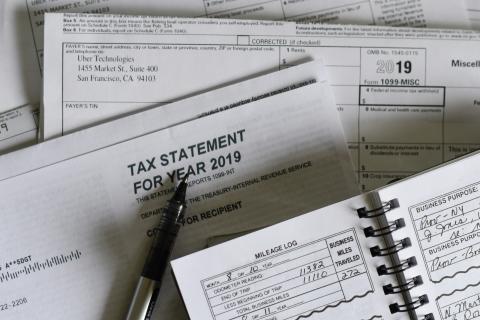Report finds Ohio’s tax system is among the most unequal in the country

Listen to this Episode
Ohio’s poorest residents pay a greater percentage of their income to state and local taxes than the richest Ohioans, according to a recent report from the nonpartisan Institute on Taxation and Economic Policy.
It found that Ohio has the 15th most unequal tax system in the country.
According to the report, the state’s poorest 20% of households contribute about 12% of their income to state and local taxes.
The richest 1% of households pay about 6% of theirs.
“When you ask people what they think a fair tax code looks like, almost nobody is going to tell you that they feel that the rich should be paying lower rates than everyone else,” said Carl Davis, the institute’s research director. “Yet in Ohio and around the country, that's what we tend to see.”
Systems like this come at a cost, Davis said. They deepen income inequality and limit the amount states can generate for public services like schools and roads.
Why do the poor pay more?
Ohioans pay all kinds of different state and local taxes, from the income tax to property and sales taxes.
“A lot of revenue in Ohio is raised by taxing what people buy,” Davis said, “like their clothing or utilities or motor fuel to get to work, or taxing their homes through the property tax.”
Those tax percentages are the same for everyone, regardless of how much they make.

And the expenses add up. They end up costing poor families a higher share of their income than rich families.
So Ohio, like many other states, tries to offset this discrepancy with the income tax. That’s a progressive tax, meaning the richest households pay the highest rates.
But it’s not steeply progressive, Davis said.
“So in the big picture, when you add it all up, your gas tax, your property tax, sales tax and income tax, the overall system tilts regressive,” he said. “It ends up asking quite a bit less of high income people than of anyone else.”
Progressive vs. regressive
Davis argues for a more progressive tax system.
“There's a real purpose and intent to having some progressivity in your income tax,” he said. “Ohio arguably doesn't have enough, and certainly if your goal is to not have regressive taxation overall, which is not something that most of the public wants.”
The high rates for the poorest 20% of households have real consequences, Davis said.
“That can really make it hard for families to pay the rent, to keep food on the table, to pay the bills,” he said. “It's quite a lot to ask of someone who's in a vulnerable economic situation. And it's really not necessary.”
And, he argues, it has consequences for public services.
“If you're levying low tax rates on people who have very large amounts of income, you're really restraining the ability of the overall tax system to generate revenue,” he explained. “So there's real impacts here for how well Ohio is able to fund schools and parks and infrastructure and all these other services.”
But not everyone is convinced.

In the Ohio legislature, Republican lawmakers have proposed plans to gradually get rid of the state income tax. They argue eliminating it would draw more people and business to the state, and that since former Gov. John Kasich started eliminating income tax brackets more than a decade ago, the state’s economy has gotten stronger.
"We've had, actually, an increase of revenue,” said Rep. Adam Mathews (R-Lebanon), in a January interview with “The State of Ohio.” “When you have more economic activity coming into the state or staying in the state and growing here, whether that's sales tax or income tax, you have an increase of revenue. And we've seen sales tax continue to increase and keeping at a consistent rate.”
Davis questions this logic.
“A lot of the narrative around what income tax cutting or income tax elimination would mean for economic growth, I don’t think that aligns with the reality,” he said. “If you look at the actual economic experience of states that have income taxes or that don’t have those taxes, it’s a very mixed bag. There’s no clear evidence that having a lower income tax will lead to faster growth.”
Other states’ approaches
If Ohio wanted to even the playing field, Davis said it could borrow ideas from other states.
“The states that we see with less regressive tax code, states like Minnesota and Vermont, they have things in common,” Davis said. “They often have more robust income taxes than Ohio does.”
More states are also implementing refundable tax credits, like the child tax credit, he said.
In Massachusetts, a voter approved initiative created a higher income tax credit on millionaires. It’s raising billions of dollars a year for education and infrastructure.
“There are real policy choices to be made here that do make a huge difference,” Davis said. “There are ways to bring down taxes for lower income earners.”
9(MDYwODMwNTczMDE2ODk5NTExNDAyNzM5Ng000))
- Home
- Schedules
- TV
- TV
- Local TV Programs
- Business | Life 360 with Kristi K.
- Toledo Stories
- To The Point with Doni Miller
- Listening with Keith Burris
- Ideas & Insights
- WGTE Presents
- BL360: Northwest Ohio Innovation Consortium
- Magic of the Old West End
- Freedom Means Never Surrender
- I&I: The Random Factor
- FF: National Cherry Festival
- TTP: Moms Demand Action For Gun Sense in America
- Watch Live
- Radio
- Education
- Community
- Support
- About
- Donate
- Watch Live


